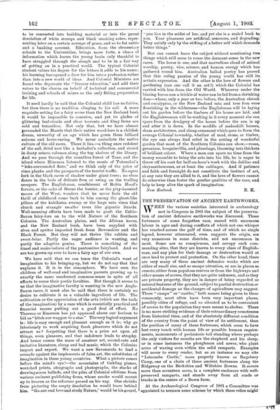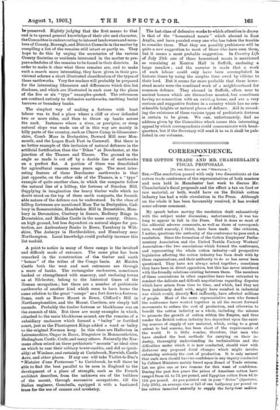THE PRESERVATION OF ANCIENT EARTHWORKS.'
NAT HEN the various societies interested in archaeology met in Congress in 1901 the subject of the preserva- tion of ancient defensive earthworks was 'discussed. These fortresses of some forgotten race, reared with enormous labour in ages and during conflicts of which not one whisper has reached across the gulf of time, and of which no single legend, however attenuated, even suggests the origin, are • very numerous in some districts, and not uncommon in most. Some are so conspicuous, and occupy such com- mending sites, that they are known to every class of English. man, and any plan for their damage or destruction would at once lead to protest and protection. On the other hand, there are very many of these ancient defensive works which are either of small size, and so escape attention, or are in places so remote, either from populous centres or from the highways and other means of access, that they are quite unknown, and as they are private property, they are in danger of being regarded as natural features of the ground, subject to partial destruction or accidental damage as the changes of agriculture may suggest. These " camps " or" castles," both names being given to them commonly, must often have been very important places, possibly cities of refuge, and so situated as to be convenient of access to the population they were meant to shelter. There is no more striking evidence of their extraordinary remoteness from historical time, and of the absolutely different condition of the country from the point of view of its settlement, than the position of many of these fortresses, which seem to have lost every touch with human life or possible human require- ments, monuments of prehistoric toil standing where perhaps the only visitors; for months are the shepherd and his sheep, or in some instances the ploughman and sower, who plant acres of waving corn within the solid ramparts. Examples will occur to every reader, but as an instance we may cite " Letcombe Castle," more properly known as Scegsbury Camp, one of a chain of these ancient fortresses along the Ridgeway on the Berkshire and Wiltshire Downs. It covers more than seventeen acres, is a complete enclosure with well preserved ramparts, and stands away from all roads or tracks in the centre of a Down farm.
At the Archaeological Congress of 1901 a Committee was appointed to -prepare some scheme by which these relies might- be preserved. Rightly judging that the first means to that end is to spread general knowledge of their site and character, the Committee is endeavouring to interest landowners and mem- bers of County, Borough, and District Councils in the matter by compiling a list-of the remains still intact or partly so. They hope to do this by urging the secretaries of the various County Societies or residents interested in the matter to pre- pare schedules of the remains to be found in their districts. In order to make it clear what these remains are, and to make such a search more interesting, they have given in their pro- visional scheme a short illustrated classification of the types of these earthworks. Very few readers will probably be prepared for the interesting likenesses and differences which this list discloses, and which are illustrated in each case by the plans of the five or six " type " examples quoted. The references are confined entirely to defensive earthworks, omitting burial barrows or boundary banks.
The simplest way of making a fortress with least labour was to find a place where a cliff or river defended two or more sides, and then to throw up banks across the neck. Instances where a river, or precipice, or steep natural slope was made use of in this way are mainly in hilly parts of the country, such as Cleeve Camp in Gloucester- shire, Comb Moss in Derbyshire, Doward Hill near Mon- mouth, and the Logan Rock Fort in Cornwall. But there is no better example of this inclusion of natural defences in the artificial fortification than the " Dikes " at Dorchester, at the junction of the Thames and Theme. The ground in the angle so made is cut off by a double line of earthworks on a perfect flat. A portion of these was demolished for agricultural reasons some years ago. The most inter- esting feature of these Dorchester earthworks is that just opposite, on the other side of the Thames, is a " type " example of quite another class, in which the ramparts follow the natural line of a hilltop, the fortress of Sinodun Hill. Supplying in imagination the heavy timber walls which no doubt stood on the top of these earth ramparts, the formid- able nature of the defence can be understood. In the class of hilltop fortresses are mentioned Mam Tor in Derbyshire, Cad- bury in Somersetshire, Hambledon Hill in Dorsetshire, Hem- bury in Devonshire, Cissbury in Sussex, Badbury Rings in Dorsetshire, and Maiden Castle in the same county. Others, on high ground, but less dependent on natural slopes for pro- tection, are Ambresbury Banks in Essex, Yarnbury in Wilt- shire, The Auberys in Hertfordshire, and Hunsbury near Northampton. Local knowledge could probably increase this list tenfold.
A point to notice in many of these camps is the involved and difficult mode of entrance. The same plan has been remarked in the construction of the timber and earth
"bomas " of the tribes of the Congo basin. At Maiden Castle both the west and east entrances are through a mane of banks. The rectangular enclosures, sometimes backed or strengthened with masonry, and enclosing towns as at Silchester, belong to the historical times of the Roman occupation ; but there are a number of prehistoric earthworks of another kind which seem to have borne the same relation to the great " camps " as a fort does to a fortress. Some, such as Bures Mount in Essex, Clifford's Hill in Northamptonshire, and the Mount, Caerleon, are simply tall mounds. Probably the timber fortress or blockhouse was on the summit of this. But there are many examples in which, attached to the main blockhouse mound, are the remains of a subsidiary enclosure which formed a " bailey " or fortified court, just as the Plantagenet Kings added a ward or bailey to the original Norman keep. In this class are Hallerton in Leicestershire, Ongar in Essex, Dingestow in Monmouthshire, Hedingham Castle, Corfe, and many others. Naturally the Nor- mans often seized on these prehistoric" mounts "as ideal sites on which to rear their solitary tower-castles, and did so (prob- ably) at Windsor, and certainly at Carisbrook, Norwich, Castle Acre, and other places. If any one will take Viollet-le-Duc's " Histoire d'une Forteresse " to Carisbrook, he will there be able to find the best parallel to be seen in England to the development of a place of strength, such as the French architect describes, from the unknown era of the builders of the mount, through successive occupations, till the Italian engineer, Genoballa, equipped it with a bastioned trace for the use of cannon and musketry. The last class of defensive works to which attention is drawn is that of the "homestead moats" which abound in Emit Anglia, and have puzzled every one who has taken the trouble to consider them. That they are possibly prehistoric will be quite a new suggestion to most of those who have seen them, but it seems a most probable suggestion. In Country Lee of July 25th one of these homestead moats is mentioned as remaining at Kenton Hall in Suffolk, enclosing a large meadow ; and the surmise is made that a work of such labour could only have been accomplished in historic times by using the surplus time owed by villeins to their lord. But it seems far more probable that these home- stead moats were the combined work of a neighbourhood foil common defence. They abound in Suffolk, often near to ancient houses which are themselves malted, but sometimeti having no connection with an existiug house, and are a very curious and suggestive feature in a country which has no con- siderable heights or natural places of defence. Aid in record- ing the existence of these various types of prehistoric fortress is certain to be given. We can, unfortunately, find no address given by the Committee which issues this interesting appeal by which correspondents could communicate with head- quarters, but if the Secretary will send it to us it shall be pub, lished in our columns.







































 Previous page
Previous page